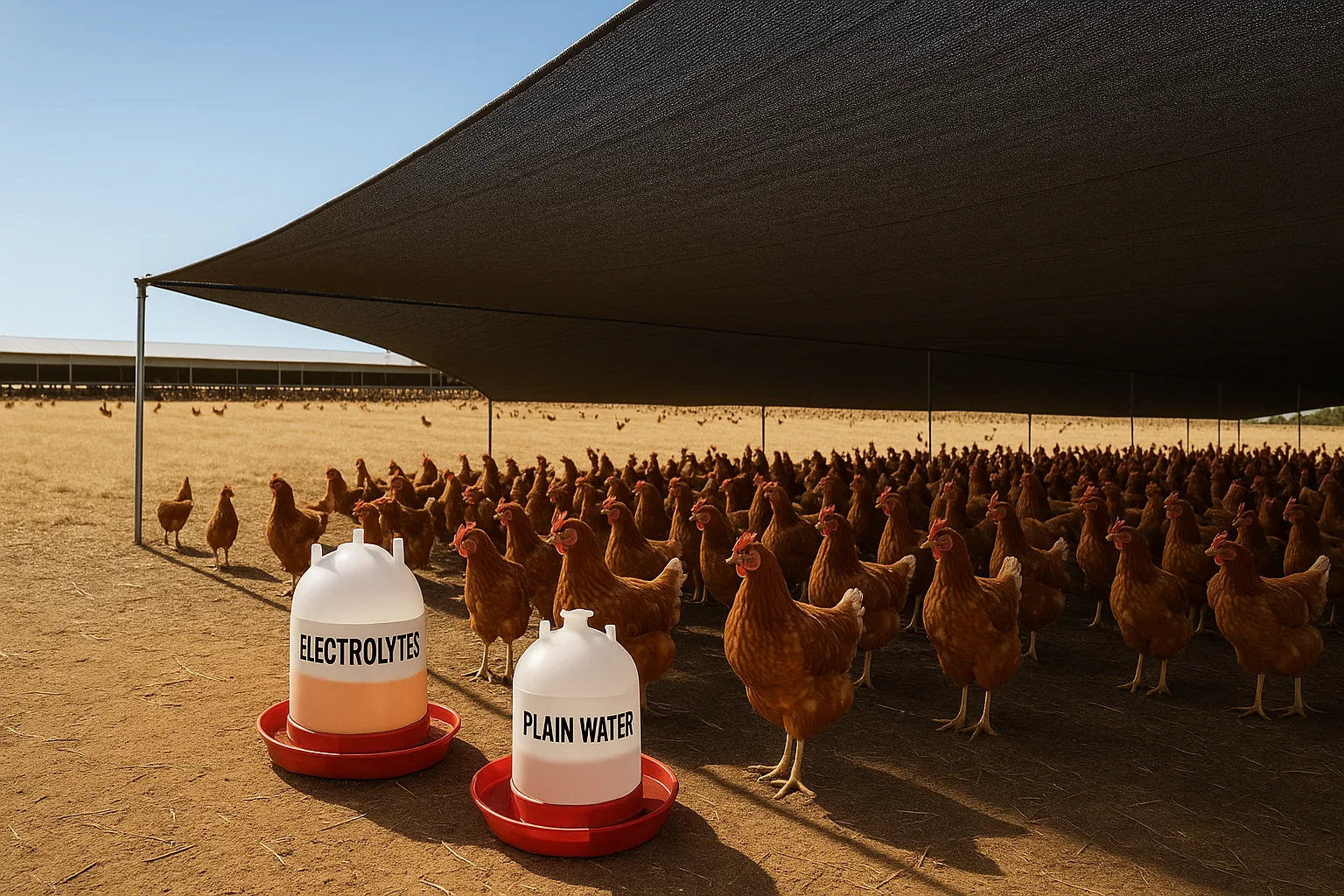Beat the Heat: Essential Hot Weather Hacks Every Chicken Keeper Must Know

Summer sunshine might be welcome, but soaring temperatures pose a serious threat to our feathered friends. Chickens are remarkably inefficient at cooling themselves – they can’t sweat! Instead, they rely on panting, holding wings away from their bodies, and reducing activity. When the mercury climbs, heat stress becomes a real danger, leading to reduced egg production, dehydration, and even fatal heatstroke. Protecting your flock isn’t just kind; it’s crucial. Here’s your arsenal of hot weather hacks to keep your chickens cool, hydrated, and thriving all summer long.
1. Hydration is Non-Negotiable: Beyond the Basic Waterer
- Ample Supply & Multiple Stations: Double or triple your water sources. Scatter them in shady spots around the run. Ensure there’s always fresh, cool water available. Evaporation and consumption skyrocket in heat.
- Keep it Cool: Place waterers in the deepest shade possible. Consider sinking plastic waterers partially into the ground – the earth acts as a natural cooler. Add ice blocks or frozen water bottles to waterers throughout the day to chill the water.
- Electrolyte Boost: During extreme heat waves (above 90°F/32°C), add poultry electrolytes to their water. This replenishes minerals lost through panting and encourages drinking. Crucial: Always provide plain water alongside electrolyte water so they have a choice.
- Frozen Treats: Freeze water with berries, peas, corn, or mealworms inside large containers (like yogurt tubs). Place these “chickensicles” in the run. Pecking at the ice provides hydration, entertainment, and cool relief. Freeze chunks of watermelon or cucumber – they are mostly water and chickens adore them.
- Cleanliness is Key: Scrub waterers daily in hot weather. Algae and bacteria grow rapidly in warm water, discouraging drinking and potentially causing illness.
2. Master the Shade Game: Creating Cool Retreats
- Natural Shade: Maximize existing shade from trees and shrubs. If possible, plant fast-growing, chicken-safe shade plants (like sunflowers or Jerusalem artichokes) around the run perimeter.
- Artificial Shade Structures: Tarps, shade cloth (50-70% density is ideal), corrugated roofing panels, or even old bedsheets can be rigged over significant portions of the run and coop areas. Ensure they are securely anchored against wind.
- Ventilation, Ventilation, Ventilation: This is paramount inside the coop. Ensure ample airflow without creating harmful drafts directly on roosting birds. Open all vents and windows (covered securely with hardware cloth). Consider adding a roof vent or ridge vent for hot air to escape. A small, secure fan pointed across the coop, not directly at birds, can significantly improve air circulation on still nights.
- Cool Ground Access: If possible, allow access to a dirt or sand area under shrubs. Chickens will dig shallow “dust baths” in cooler earth to regulate their temperature.
3. Dietary Adjustments for Hot Days
- Feed Smart: Chickens generate heat digesting food. Offer their main ration during the coolest parts of the day – early morning and late evening. Reduce the amount slightly if they seem less interested.
- Cool, Hydrating Treats: Focus on high-water-content foods:
- Watermelon, Cantaloupe, Cucumber: Huge favorites and incredibly hydrating.
- Frozen Peas or Corn: Toss them frozen into the run for a fun, cool snack.
- Leafy Greens: Lettuce, kale, chard (offer in moderation).
- Plain Yogurt (Cool, not frozen): A probiotic boost in small amounts.
- Limit Scratch & Corn: These grains generate more internal heat during digestion. Save them for cooler weather or offer very sparingly as a late-evening treat.
- Probiotics: Consider adding probiotics to their water or feed. Heat stress can disrupt gut health, making them more susceptible to illness.
4. Active Cooling Techniques (Use Judiciously)
- Misting Systems: A fine mist sprayed above the run or in a specific shaded area (not directly on chickens or their coop) can significantly cool the ambient air through evaporation. Ensure it’s fine mist, not soaking wet, and always provides dry areas for birds to retreat to. Never mist a closed coop!
- Shallow Pools/Pans: Place very shallow pans (like large plant saucers or kiddie pools with just an inch of water) in shady spots. Some chickens will stand in them to cool their feet. Ensure they are safe and easy to exit. Not all chickens will use these.
- Frozen Bottles/Tiles: Freeze plastic water bottles or ceramic tiles. Place them in the run. Chickens will often sit near or lean against them to absorb the coolness. Wrap bottles in a thin towel if condensation is excessive.
5. Recognizing & Responding to Heat Stress: Know the Signs!
Act immediately if you see:
- Heavy, Open-Mouth Panting: The most obvious sign.
- Wings Held Away from Body: Trying to increase air circulation.
- Pale Combs and Wattles: Can indicate distress.
- Lethargy/Lack of Movement: Sitting hunched or sprawled.
- Reduced or Stopped Egg Production.
- Diarrhea.
Emergency Cooling for a Heat-Stressed Chicken:
- Move Immediately: Get the bird to a cool, shaded, quiet area.
- Submerge Feet/Legs: Place the chicken in cool (not ice-cold!) water up to its belly for 5-10 minutes. This cools blood circulating near the surface.
- Offer Cool Water: Encourage drinking, perhaps with electrolytes.
- Use Damp Towels: Gently apply cool, damp cloths to comb, wattles, and under wings.
- Air Circulation: Use a fan nearby (not directly blowing hard on them) to aid evaporation.
- Vet Contact: Severe cases require immediate veterinary attention.
Bonus Hacks & Pro Tips:
- Dust Bath Refreshment: Ensure dust bath areas are available and in the shade. You can slightly dampen the dust bath sand/dirt in the morning – it will stay cooler longer.
- Avoid Handling: Minimize catching and handling chickens during peak heat, as it stresses them further.
- Coop Check: Visit the coop during the hottest part of the day. Is it significantly cooler than outside? Is the ventilation adequate? Is the water still cool?
- Breeds Matter: If you live in a consistently hot climate, consider heat-hardy breeds like Leghorns, Andalusions, Minorcas, or Easter Eggers when adding to your flock. Avoid heavily feathered breeds like Brahmas or Cochins if heat is a major concern.
- Mulch the Run: A layer of straw or wood chips in shaded run areas stays cooler than bare dirt.
- Cool Roosts: If possible, ensure roosts aren’t crammed together and have good airflow around them.
Prevention is Paramount: Don’t wait for signs of distress. Implement these hacks proactively as soon as temperatures rise consistently above 80°F (27°C). Your vigilance and these simple strategies will ensure your flock sails through summer comfortably, healthily, and happily, rewarding you with their distinctive clucks and (eventually) plenty of eggs when the weather cools.
